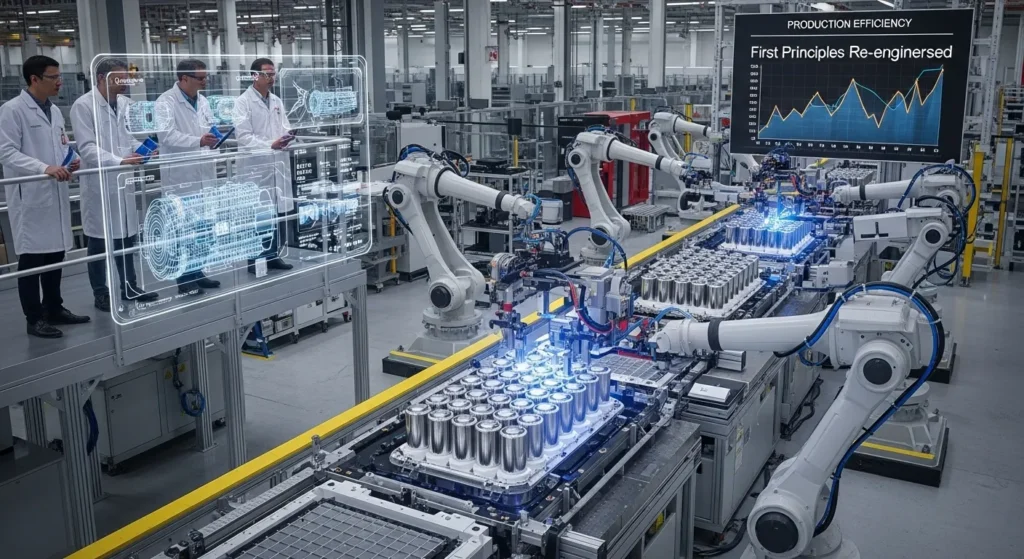Table of Contents
Engineering from First Principles gives the right to the thinking engineers to solve complex problems by breaking down the main elements, challenging beliefs, and systematically constructing solutions. This approach runs innovation, efficiency, and durable engineering, affecting mechanical design, material science, manufacturing, and software development worldwide.
Historical Background
The idea of Engineering from First Principles arises from Aristotle, who believed that all knowledge should come from basic, self-supreme truth. Later, philosophers such aRenéne Descartes and Emmanuel Kant emphasized logic from these principles to create a complex understanding. In the 20th century, Richard Fenman popularized Fenman technology – a method of breaking concepts into fundamental components for conflict and problem-solving.
Core Concept: What Are First Principles?
A first principle is a basic truth that cannot be extracted from anything else. In engineering, this means that before designing the solution, engineers must understand forces, physical properties, energy transfer, and system behavior at its most basic level.
Four Stages of Implementing the First Principles
The first step is to identify the problem and clearly define the challenge. The next step is to break the problem into fundamental components. Then comes the stage of challenging existing beliefs and questioning accepted limitations and prior perceptions. Finally, engineers build a solution from the ground up, creating a customized and innovative result.

Machine Design
When designing mechanical systems, engineers apply Newton’s laws, stress analysis, and rules of material science to create efficient and reliable machines. This approach has revolutionized manufacturing, robotics, and transport by eliminating inefficiencies and improving overall performance.
Material Science and Manufacturing
In material science, Engineering from First Principles helps engineers understand nuclear structures, which has led to major successes in metallurgy, advanced materials, and modern manufacturing. This knowledge allows the creation of lighter, stronger, and more durable materials that benefit industries from aerospace to medical devices.
Applications in Software Engineering
The thinking of Engineering from First Principles is not limited to physical systems. In software engineering, it clarifies user needs, defines minimal viable product architecture, and supports API design, search and filter functionality, and data modeling. This results in lean, scalable, and user-friendly solutions.
Research Insight
Research shows that this approach delivers measurable results. MIT (2022) found that engineering teams that applied first principles reduced the design cycle time by 30 percent. Harvard Business Review reported higher innovation rates in companies using root cause analysis and systematic argumentation. IEEE studies revealed that first-principles-inspired engineering improves resource efficiency and reduces waste in manufacturing by 25 percent.
Difference from Traditional Thinking
Engineering from First Principles begins with fundamental truth, while traditional thinking depends on similes and previous solutions. It encourages unconventional solutions, whereas traditional approaches often lead to incremental improvements.
First principles thinking removes inherited flaws and optimizes resource use, while traditional methods may carry inefficiencies. It also adapts easily to new technologies, whereas traditional thinking may resist change. Finally, first principles thinking challenges flawed assumptions early, while traditional approaches may overlook hidden risks.
Real-World Case Studies
Elon Musk used Engineering from First Principles to re-engineer Tesla battery production, analyzing costs and redesigning processes at the raw material level, which resulted in inexpensive, high-capacity batteries.
SpaceX questioned the notion that rockets should be discarded after one use and developed reusable boosters, dramatically reducing launch costs. Apple applies first principles to product design, focusing on minimalism, intuitive interface, and maximizing performance by removing unnecessary features.
Toyota uses root cause analysis through the “five whys” method to continuously improve manufacturing efficiency and reduce waste.

Benefits of the First Principles in Engineering
The benefits of Engineering from First Principles include the ability to drive innovation by encouraging novel problem-solving, improving efficiency by removing unnecessary complexity, and allowing rapid adaptation to change. It also reduces waste and supports environmentally friendly and sustainable design goals.
Downsides and Limitations
The first challenge of this approach is that it can be time-consuming, as it requires deep and intensive analysis. There is also the risk of over-analysis, which can slow decision-making. Finally, it demands an open mind, as it often challenges long-standing assumptions and accepted beliefs. This topic ties closely with Is Zinc Magnetic? Truth, Properties & Alloys Explained.
Key Takeaways
The first principles approach breaks problems into their essential truths before creating a solution. It encourages innovation, efficiency, and stability, and can be applied across engineering, software, and product design. Research supports its ability to shorten design cycles and improve efficiency. Tesla, SpaceX, Apple, and Toyota have successfully used this approach to achieve industry-defining results.
Conclusion
Engineering from First Principles is the cornerstone of modern engineering. It allows engineers to question assumptions, break problems down into their fundamental truths, and create customized solutions. Whether applied to mechanical design, software architecture, or sustainable engineering, this mindset ensures continuous innovation and improved performance.








